


China.org.cn | November 17, 2023
In the Shuitingmen historical neighborhood of Quzhou city, Zhejiang province, the Doolittle Raid Memorial Hall serves as a vivid reminder of a significant episode from World War II.
Its extensive collection of artifacts and photographs chronicles the events of 81 years ago, offering insight into a pivotal moment when the paths of China and the U.S. intersected.

The Doolittle Raid Memorial Hall opens on Oct. 25, 2018, in Quzhou, Zhejiang province. [Photo provided to China.org.cn]
The raid and the Chinese rescue
The story dates back to April 18, 1942, when the U.S., seeking retaliation against Japan's attack on Pearl Harbor, assembled 80 pilots for the Doolittle Raid. The mission, led by Lieutenant Colonel James Doolittle, marked the first successful U.S. military bombing on Japanese soil during World War II, targeting Tokyo and four other cities.
However, the return journey of these pilots was fraught with challenges. Disoriented by darkness and bad weather, many had to abandon their planes over China's Jiangxi, Zhejiang, Anhui, and Fujian provinces.
The Chinese military and civilians launched a massive rescue operation, successfully evacuating 64 American pilots, with 51 of them finding refuge in Quzhou.
The people of Quzhou, upon learning that these foreign soldiers were there to "fight the Japanese," bravely sheltered, transported, and cared for the American pilots. They carried the weary and hungry men across rugged terrain, shared their scarce food, and protected them at great personal risks.
In retaliation, the Japanese army launched a brutal attack in Zhejiang and Jiangxi provinces, leading to the loss of 250,000 lives. The month following the raid saw relentless bombing of Quzhou airport and a brutal campaign of germ warfare in the city.
Data shows that nearly 30 counties across seven cities in Zhejiang were affected by the biological warfare, with about 60,000 deaths and hundreds of thousands injured. Quzhou suffered the most, with 40,000 deaths.
The Doolittle Raid Memorial Hall
Years later, this history still resonates. From the 1990s onwards, survivors of the Doolittle Raid and their descendants began visiting Quzhou. On Oct. 25, 2018, descendants of the Doolittle Raiders attended the opening of the Memorial Hall.
Most of them were then elderly, crossing the ocean not just to remember their forebears but also to express gratitude to the brave Quzhou soldiers and civilians.
The Memorial Hall showcases over 200 historical photos and nearly 200 artifacts related to the Doolittle Raid, including models of the USS Hornet aircraft carrier and the B-25 bombers, and replicated newspapers reporting on the mission.
Quzhou citizens have contributed to the museum, including local historian and collector Zheng Weiyong, who has donated items such as Doolittle Raid survivors' signed crash relics and inscriptions from Madame Soong Mei-ling to the rescued American pilots.
The son of Thomas Carson Griffin, a member from the Doolittle Raid's Crew 9, donated his father's treasured artifacts, including a blood chit, to the museum, hoping that the friendship solidified in wartime can be forever remembered by the people of both nations.
